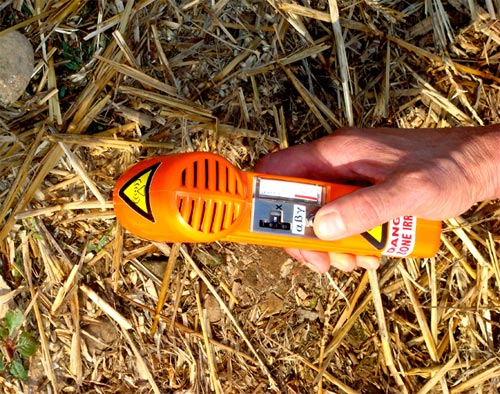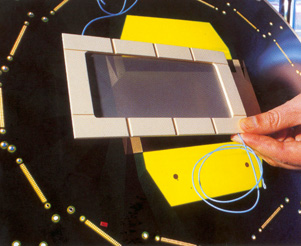Design « eyes » sensitive to invisible rays …
Radioactivity is a quasi invisible phenomenon. It has been discovered lately, around 1900, owing to the lack of « eyes », at this time, able to observe the emitted radiation.
The first tool allowing to « see » the effects of radiation on matter was the fluorescent screen which allowed Röntgen in 1895 to indirectly observe X-rays. The following year in 1896, Henri Becquerel observed unexpectedly traces of rays emitted by uranium salts on a photographic plate. Later, Pierre and Marie Curie were able to measure the intensity of radioactive decays using a piezoelectric electrometer whose current was proportional to the activity. of a radioactive sample. Finally, in the early twentieth century the German physicists Hans Geiger and Walther Müller invented the first gas detector able to detect in real time individual radiations emitted by a radioactive source: the famous Geiger counter.
of a radioactive sample. Finally, in the early twentieth century the German physicists Hans Geiger and Walther Müller invented the first gas detector able to detect in real time individual radiations emitted by a radioactive source: the famous Geiger counter.

Small Geiger-Müller counter
Example of Environmental Control using a small portable Geiger-Müller detector that can highlight hotspots of activity above the ambient natural radioactivity.
© DR
Since then, different types of detectors (gaseous, liquid or solid scintillators, semiconductors …) have been designed to observe the different radiations of natural and artificial radioactivity. These detectors can be classified into two main categories: charged particle detectors (electrons, positrons, protons, alpha …) and the neutral particle detectors (neutrons, gamma, neutrinos).
In particle and nuclear physics it is often necessary to detect non only a particle but its trajectory. Early detectors were cloud chambers, which allowed to discover the positron in 1934, the bubble chambers in the years 1960 for particle physics experiments. Later on, were developped electronic tracking devices, such as track chambers or wire chambers, which offer immediates responses. For instance, the development of the wire chamber got the French physicist Georges Charpak the 1992 Nobel Prize.

Wire Chamber
This detector, comprised of an array of wires set at very high tensions, allows for accurate detection of the position of the particles which go through. This model is a great improvement on the early Geiger counters, which were only able to indicate whether a particle had gone by or not.
© CNRS
Accordingly to the desired objective, a detector may have one or several functions :
– highlight « hot spots » of radioactivity in the environment,
– Measure accurately the activity of a radioactive source or sample,
– Measure the energy of radiations and identify the emitting radionucleus,– Identify the emitted radiation (mass, electric charge),
– reconstruct its trajectory.
In each case, the detector should have well adapted characteristics, among which one can mention :
– High detection efficiency,
– A good energy resolution (ability to distinguish between gamma or X rays of very similar energies)
– A rapid response time,
– A low background noise,
– A reasonable cost !
The most advanced detectors are used in research laboratories. Others monitor the radioactivity of sites where radioactive nuclei are produced or present. Smaller and simpler detectors are also used for radiation protection or the monitoring of radioactivity in the environment.
Articles on the subject « Detection tools »
Detection Principles
Amplify the traces of the passage of a microscopic particle … The phenomenon of ionization [...]
Detection Sensitivity
Counting the decays of radioactive atoms Radioactivity is an unrivaled instrument for exploring t[...]
Geiger Counters
A detector widely used in dosimetry, radioprotection, physics and industry Widely used because of[...]